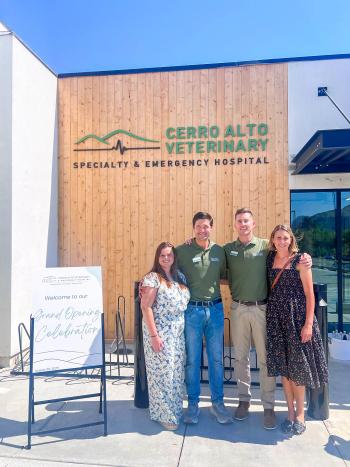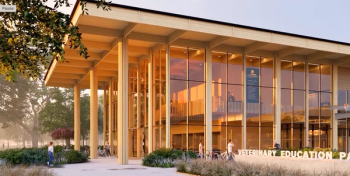
Do you, doctor, lease ... or build?
It's the question that every new generation of veterinarians faces.
So, you're not sure you're ready to give up your freewheeling days as a carefree associate. Or maybe you're an owner wondering whether to leave behind your paid-off clinic and build a new and better one on credit. Don't worry; you're not alone. This is a perennial question that every new generation of veterinarians faces: Will you find the perfect space to lease—or will you buy land and build a brand-new hospital?
Illustration by Gail Armstrong.
There are situations where a leased facility is ideal and others where it's best to build. As you weigh the stakes, ask yourself these three main questions. Your answers will help you figure out whether a leasehold or a new freestanding facility is best for you, and you'll feel more confident in your choice—plus the numbers will help back up your decision.
1. Where will I put my practice?
Location, location, location. It's important. You want maximum visibility—a well-trafficked street, intersection, or commercial area. If the only place to build a brand-new hospital is an out-of-the-way industrial park that sends clients driving in circles looking for you, you'll want to lease. The more visible your hospital, the less you'll need to spend on marketing. Your best advertisements will be word-of-mouth and "Hey, look, there's a veterinary hospital nearby."
You might also consider leasing if you're relocating your practice and need to move somewhere close to your current facility. Many of your clients won't travel long distances to follow you, especially if they'll pass three other veterinary hospitals on the way. You also need land or a building that's zoned for veterinary use.
Whether you lease or build is also contingent on your practice's revenue base and its potential for growth. Conduct a demographic study to find out whether the client population in the area you're considering will bring in enough revenue to support your new facility's cost of occupancy. Occupancy cost in the form of rent or ownership costs is usually 5 percent to 8 percent of hospital revenue. If your revenue doesn't support the occupancy cost, your new facility will be unaffordable and it's time to look elsewhere. (See "Can You Afford Your New Practice?") It's usually easier to look for a new location than to desperately hunt for more revenue in your business plan.
2. What can I afford?
If you're starting a brand-new practice without clients, you'll need short-term savings on hand. No savings? Then leasing is for you. It's the least-expensive way to get off the ground when there's no revenue coming in. The usual leasehold is in a strip mall where building costs are shared with other tenants. To entice you to enter into a lease, the landlord may even provide you free rent or pay for a portion of the cost of "fitting up" the space.
To see why a lease is attractive, consider the costs of building fresh:
• Most veterinary hospitals cost at least $200 a square foot. The average hospital built today is 5,000 square feet. That's $1 million. The cost of the land, architects, and engineers is at least another $500,000. Now you're up to $1.5 million.
• The annual cost of the mortgage on a $1.5 million project on a 20-year note at 6.5 percent is roughly $134,000.
• For this figure to amount to only 7 percent of your gross revenue, you need annual sales of $1.9 million.
• At about $500,000 per full-time-equivalent doctor, that'll take a four-doctor hospital to make it work.
• And as the owner, you'll most likely need to put 10 percent down—$150,000 in cash—to start the project. If these numbers make you cringe, leasing might be your best choice.
3. What can I expect to amass in long-term value?
Consider these drawbacks to leasing before you sign on the dotted line:
• For all the rent you'll pay, you won't get equity. If you don't own the building or the land, you'll have nothing to show for your rent payments at the end of the lease. The property equity belongs to the landlord, even though you may have been the one to increase its value.
Can you afford your new practice?
• Selling gets tricky. Many years from now when you sell your practice, you don't want your landlord to have power over the transaction. But if he or she tries to force your potential buyer to renegotiate the lease or retains the right to approve or disapprove your buyer as a tenant, power is exactly what the landlord will have. The solution? Get a "right of assignability" in your lease so you can transfer the lease to the veterinarian taking over. Better yet, even if you're leasing land, why not try to buy the building? Real estate is a great retirement asset with a good market return, yielding up to 12 percent appreciation per year.
• Leasehold improvements don't belong to you. You may be able to take mobile cabinets and furniture with you when you move out, but everything else will stay. And because leasehold renovations are considered an intangible asset, finding lenders to finance these projects can be tough—banks don't want to lend you money for improvements you won't own. Veterinary-specific lenders can play an important role here because they understand this environment better than local banks. (See "Getting a Loan in Today's Market" on the next page for advice on how to secure financing for your new hospital.)
• You could be building up the competition. If you move out of your leasehold and into another local facility, who is your landlord going to try to find to lease this ready-made veterinary space? Another veterinarian, of course. You can try to negotiate a clause in your lease that prohibits the space from being rented to another veterinarian for a period of time—say two years—but it may be a hard point to win. You will, however, be better positioned to negotiate such a clause with a long-term lease. Long-term leases are better for veterinary space because they create stability, which benefits both you and your landlord. The proper way to structure a long-term lease to your best advantage is with short periods and options to renew—for example, a 20-year lease set up with an initial five-year term and three additional five-year renewal options. This gives you the flexibility to break out if you need to.
• Expansion is tough. Leases also carry limitations on increasing your space and may restrict your ability to offer such services as boarding or grooming.
For many veterinarians, the choice to build or lease is right up there with "Will you marry me?" or deciding to say "Yes!" It's not easy. Think it through and decide what works best for your future. Make sure your business plan is married to the right hospital—leasehold or new construction.
Gary I. Glassman, CPA
Gary I. Glassman, CPA, is a Veterinary Economics Editorial Advisory Board member and partner with Burzenski and Co. in East Haven, Conn. Catch his talks "Can You Afford to Build Your Dream Facility?" and "Figuring Out Financing" at the Veterinary Economics Hospital Design Conference, held in conjunction with CVC Central, Aug. 20 to 22 in Kansas City, Mo. Send questions or comments to
Newsletter
From exam room tips to practice management insights, get trusted veterinary news delivered straight to your inbox—subscribe to dvm360.






